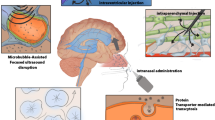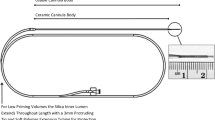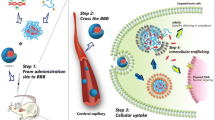Abstract
Certain central nervous system (CNS) diseases are characterized by the degeneration of specific cell populations. One strategy for treating neurodegenerative diseases is long-term, controlled delivery of proteins such as epidermal growth factor (EOF) and nerve growth factor (NGF). Since proteins permeate through brain capillaries very slowly, local administration using polymeric implants, continuous infusion pumps, or transplanted, protein-secreting cells may be required to achieve therapeutic concentrations in the tissue. The efficiency of local distribution, and hence effectiveness of local therapy, depends on the rate of protein migration through tissue. The rate of dispersion of molecules in a quiescent, isotropic medium can be characterized by the molecular diffusion coefficient, D, which can be measured by techniques such as quantitative autoradiography, iontophoresis, and fluorescence photobleaching recovery (FPR). These methods are reviewed, with an emphasis on their application to measurement of D for proteins in the brain. Biophysical techniques yield quantitative descriptions of local protein distribution and may enable discrimination of mechanisms of protein transport in the brain. This capability suggests a new paradigm for design of protein therapies, in which proteins and delivery systems are collectively customized to provide sustained protein availability over predetermined volumes of tissue.
Similar content being viewed by others
REFERENCES
A.N. Lieberman. First Ever National Institutes of Health Research Planning Workshop on Parkinson's Disease, National Parkinson Foundation (1995).
Progress Report on Alzheimer's Disease. National Institute on Aging (1996).
M. Mouradian, J. Juncos, G. Fabbrini, and T. Chase. Motor fluctuations in Parkinson's disease: Pathogenic and therapeutic studies. Ann. Neurol. 22:475–479 (1987).
K. L. Davis, L. J. Thal, E. R. Gamzu, C. S. Davis, R. F. Woolson, S. I. Gracon, D. A. Drachman, L. S. Schneider, P. J. Whitehouse, and T. M. Hoover. A double-blind, placebo-controlled multicenter study of tacrine for Alzheimer's disease. N. Engl. J. Med. 327:1253–1308 (1992).
G. Ferrari, G. Toffano, and S. D. Skaper. Epidermal growth factor exerts neuronotrophic effects on dopaminergic and GABAergic CNS neurons: Comparison with basic fibroblast growth factor. J. Neurosci. Res. 30:493–497 (1991).
J. Villares, B. Faucheux, O. Strada, E. Hirsche, Y. Agid, and F. Javoy-Agid. Autoradiographic study of [125I]epidermal growth factor-binding sites in the mesencephalon of control and Parkinsonian brains post-mortem. Brain Res. 628:72–67 (1993).
M. Mogi, M. Harada, T. Kondo, P. Riederer, H. Inagaki, M. Minami, and T. Nagatsu. Interleukin-1β, interleukin-6, epidermal growth factor and transforming growth factor-α are elevated in the brain from Parkinsonian patients. Neurosci. Let. 180:147–150 (1994).
S. Weiss, C. Dunne, J. Hewson, C. Wohl, M. Wheatley, A.C. Peterson, and B.A. Reynolds. Multipotent CNS stem cells are present in the adult mammalian spinal cord and ventricular neuroaxis. J. Neurosci. 16:7599–7609 (1996).
C. Craig, T. V. C. Morshead, B. Reynolds, S. Weiss, and D. van der Kooy. In vivo growth factor expansion of endogenous subependymal neural precursor cell populations in the adult mouse brain. J. Neurosci. 16:2649–2658 (1996).
V. Koliatsos, M. Applegate, B. Knusel, E. Junard, L. Burton, W. Mobley, F. Hefti, and D. Price. Recombinant human nerve growth factor prevents retrograde degeneration of axotomized basal forebrain cholinergic neurons in the rat. Exp. Neurol. 112:161–173 (1991).
V. E. Koliatsos, B. S. Clatterbuck, G. J. W. Nauta, B. Knusel, L. E. Burton, F. F. Hefti, W. C. Mobley, and D. L. Price. Human nerve growth factor prevents degeneration of basal forebrain cholinergic neurons in primate. Ann. Neurol. 30:831–840 (1991).
M. H. Tuszynski, G. Buzsaki, and F. H. Gage. Nerve growth factor infusions combined with fetal hippocampal grafts enhance reconstruction of the lesioned septohippocampal projection. Neuroscience 36:33–44 (1990).
K. Niijima, G. R. Chalmers, D. A. Peterson, L. J. Fisher, P. H. Patterson, and F. H. Gage. Enhanced survival and neuronal differentiation of adrenal chromaffin cells cografted into the striatum with NGF-producing fibroblasts. J. Neurosci. 15:1180–1194 (1995).
L. Olson, L. Backman, T. Ebendal, M. Eriksdotter-Jonhagen, B. Hoffer, C. Humpel, R. Freedman, M. Giacobini, B. Meyerson, A. Nordberg, A. Seiger, I. Stromberg, O. Sydow, A. Tomac, K. Trok, and B. Winblad. Role of growth factors in degeneration and regeneration in the central nervous system; clinical experiences with NGF in Parkinson's and Alzheimer's diseases. J. Neurol. 241:S12–S15 (1994).
J. F. Poduslo, G. L. Curran, and C. T. Berg. Macromolecular permeability across the blood-nerve and blood-brain barriers. Proc. Natl. Acad. Sci. USA 91:5705–5709 (1994).
R. Duncan and F. Spreafico. Polymer conjugates. Pharmacokinetic considerations for design and development. Clin. Pharmacokinet. 27:290–306 (1994).
C. E. Krewson, R. B. Dause, M. W. Mak, and W. M. Saltzman. Stabilization of nerve growth factor in polymers and in tissues. Biomater. Sci. Polym. Ed. 8:103–117 (1996).
C. E. Krewson and W. M. Saltzman. Nerve growth factor delivery and cell aggregation enhance choline acetyltransferase activity after neural transplantation. Tissue Eng. 2:183–196 (1996).
C. E. Krewson and W. M. Saltzman. Transport and elimination of recombinant human NGF during long-term delivery to the brain. Brain Res. 727: 169–181 (1996).
D. Hoffman, L. Wahlberg, and P. Aebischer. NGF released from a polymer matrix prevents loss of ChAT expression in basal forebrain neurons following a fimbria-fornix lesion. Exp. Neurol. 110:39–44 (1990).
P. J. Camarata, R. Suryanarayanan, and D. A. Turner. Sustained release of nerve growth factor from biodegradable polymer microspheres. Neurosurgery 30:313–319(1992).
L. Williams, S. Varon, G. Peterson, K. Wictorin, W. Fischer, A. Bjorklund, and F. Gage. Continuous infusion of nerve growth factor prevents basal forebrain neuronal death after fimbria fornix transection. Proc. Natl. Acad. Sci. USA 83:9231–9235 (1986).
P. F. Morrison, D. W. Laske, H. Bobo, E. H. Oldfield, and R. L. Dedrick. High-flow microinfusion: tissue penetration and pharmacodynamics. Am. J. Physiol. 266: R292–R305 (1994).
D. M. Lieberman, D. W. Laske, P. F. Morrison, K. S. Bankiewicz, and E. H. Oldfield. Convection-enhanced distribution of large molecules in gray matter during interstitial drug infusion. J. Neursurg. 82:1027–1029 (1995).
M. Rosenberg, T. Friedmann, R. Robertson, M. Tuszynski, J. Wolff, X. Breakefield, and F. Gage. Grafting genetically modified cells to the damaged brain: restorative effects of NGF expression. Science 242:1575–1578 (1988).
S. R. Winn, J. P. Hammang, D. F. Emerich, A. Lee, R. D. Palmiter, and E.E. Baetge. Polymer-encapsulated cells genetically modified to secrete human nerve growth factor promote the survival of axotomized septal cholinergic neurons. Proc. Natl. Acad. Sci. USA 91:2324–2328 (1994).
D. F. Emerich, J. P. Hammang, B. E. E., and S. R. Winn. Implantation of polymer-encapsulated human nerve growth factor-secreting fibroblasts attenuates the behavioral and neuropathological consequences of quinolinic acid injections into rodent striatum. Exp. Neurol. 30:141–150 (1994).
J. H. Kordower, S. R. Winn, Y.-T. Liu, E. J. Mufson, J. R. Sladek, J. P. Hammang, E. E. Baetge, and D. F. Emerich. The aged monkey basal forebrain: Rescue and sprouting of axotomized basal forebrain neurons after grafts of encapsulated cells secreting human nerve growth factor. Proc. Natl. Acad. Sci. USA 91:10898–10902 (1994).
J. H. Kordower, J. M. Rosenstein, T. J. Collier, M. A. Burke, E. Y. Chen, J. M. Li, L. Martel, A. E. Levey, E. J. Mufson, T. B. Freeman, and C. W. Olanow. Functional fetal nigral grafts in a patient with Parkinson's Disease — chemoanatomic, ultrastructural, and metabolic studies. J. Comp. Neurol. 370:203–230 (1996).
M. J. Mahoney, and W. M. Saltzman. Controlled release of proteins to tissue transplants for the treatment of neurodegenerative disorders. J. Pharm. Sci. 85: 1276–1281. (1996).
L. T. Baxter, and R. K. Jain. Transport of fluid and macromolecules in tumors I. Role of interstitial pressure and convection. Microvasc. Res. 37:77–104 (1989).
C. P. Geer, and S. A. Grossman. Extracellular fluid flow along white matter tracts in brain: a potentially important mechanism for dissemination of primary brain tumors. Proc. ASCO 12:177 (1993).
L. Fung, M. Shin, B. Tyler, H. Brem, and W. M. Saltzman. Chemotherapeutic drugs released from polymers: distribution of 1,3-bis(2-chloroethyl)-1-nitrosourea in the rat brain. Pharm. Res. 13:671–682 (1996).
S. Yamada, M. DePasquale, C. S. Patlak, and H. F. Cserr. Albumin outflow into deep cervical lymph from different regions of rabbit brain. Am. J. Physiol. 261:H1197–H1204 (1991).
M. A. Clauss, and R. K. Jain. Interstitial transport of rabbit and sheep antibodies in normal and neoplastic tissues. Cancer Res. 50:3487–3492 (1990).
K. D. Anderson, R. F. Alderson, C. A. Altar, P. S. Distefano, T. L. Corcoran, R. M. Lindsay, and S. J. Wiegand. Differential distribution of exogenous BDNF, NGF, and NT-3 in the brain corresponds to the relative abundance and distribution of high-affinity and low-affinity neurotrophin receptors. J. Comp. Neurol. 357:296–317 (1995).
M. Mak, L. Fung, J. F. Strasser, and W. M. Saltzman. Distribution of drugs following controlled delivery to the brain interstitium. J. Neurooncol. 26:91–102 (1995).
W. M. Saltzman. Antibodies for treating and preventing disease: the potential role of polymeric controlled release. Crit. Rev. Ther. Drug Carrier Syst. 10:111–142 (1993).
W. M. Saltzman and M. L. Radomsky. Drugs released from polymers: diffusion and elimination in brain tissue. Chem. Eng. Sci. 46:2429–2444 (1991).
E. W. Thiele. Relation between catalytic activity and size of particle. Ind. Eng. Chem. 31:916 (1939).
V. Levin, J. Fenstermacher, and C. Patlak. Sucrose and inulin space measurements of cerebral cortex in four mammalian species. Am. J. Physiol. 219: 1528–1533 (1970).
K. H. Dykstra, J. K. Hsiao, P. F. Morrison, P. M. Bungay, I. N. Mefford, M. M. Scully, and R. L. Dedrick. Quantitative examination of tissue concentration profiles associated with microdialysis. J. Neurochem. 58:931–940 (1992).
J. F. Strasser, L. K. Fung, S. Eller, S. A. Grossman, and W. M. Saltzman. Distribution of 1,3-bis(2-chloroethyl)-1-nitrosourea (BCNU) and tracers in the rabbit brain following interstitial delivery by biodegradable polymer implants. J. Pharm. Exp. Ther. 275:1647–1655 (1995).
W. Dang and W. M. Saltzman. Dextran retention in the rat brain following controlled release from a polymer. Biotech. Prog. 8:527–532 (1992).
W. M. Saltzman, M. L. Radomsky, K. J. Whaley, and R. A. Cone. Antibody diffusion in human cervical mucus. Biophys. J. 66:508–515 (1994).
M. L. Radomsky, K. J. Whaley, R. A. Cone, and W. M. Saltzman. Macromolecules released from polymers: diffusion into unstirred fluids. Biomat. 11:619–624 (1990).
K. Groebe, S. Erz, and W. Mueller-Klieser. Glucose diffusion coefficients determined from concentration profiles in EMT6 tumor spheroids incubated in radioactively labeled L-glucose. Adv. Exp. Med. Biol. 361:619–25 (1994).
B. Bjelke, R. England, C. Nicholson, M. E. Rice, J. Lindberg, M. Zoli, L. F. Agnati, and K. Fuxe. Long distance pathways of diffusion for dextran along fibre bundles in brain. Relevance for volume transmission. Neuroreport 6:1005–1009 (1995).
S. Popov and M. M. Poo. Diffusional transport of macromolecules in developing nerve processes. J. Neurosci. 12:77–85 (1992).
S. Terada, T. Nakata, A. Peterson, and N. Hirokawa. Visualization of slow axonal transport in vivo. Science 273:784–788 (1996).
S. Johanson, M. Crouch, and I. Hendry. Retrograde axonal transport of signal transduction proteins in rat sciatic nerve. Brain. Res. 690:55–63 (1995).
L. Tao and C. Nicholson. Diffusion of albumins in rat cortical slices and relevance to volume transmission. Neuroscience 75:839–847 (1996).
V. A Levin, J. D. Fenstermacher, and C. S. Patlak. Sucrose and inulin space measurements of cerebral cortex in four mammalian species. Am. J. Physiol. 219:1528–1533 (1970).
J. Fenstermacher and T. Kaye. Drug “diffusion” within the brain. Ann. NY Acad. Sci. 531:29–39 (1988).
L. Nugent and R. Jain. Extravascular diffusion in normal and neoplastic tissues. Cancer Res. 44:238–244 (1984).
R. K. Jain. Barriers to drug delivery in solid tumors. Sci. Amer. 271:58–65 (1994).
R. Williams, D. Piston, and W. Webb. Two-photon molecular excitation provides intrinsic 3-dimensional resolution for laser-based microscopy and microphotochemistry. FASEB J. 8:804–13 (1994).
C. Xu, W. Zipfel, J. Shear, R. M. Williams, and W. W. Webb. Multiphoton fluorescence excitation: new spectral windows for biological nonlinear microscopy. Proc. Natl. Acad. Sci. USA 93:10763–10768 (1996).
S. Maiti, J. B. Shear, R. Williams, W. Zipfel, and W. W. Webb. Measuring serotonin distribution in live cells with three-photon excitation. Science 275:530–532 (1997).
D. Berk, F. Yuan, M. Leunig, and R. Jain. Fluorescence photobleaching with spatial fourier analysis: measurement of diffusion in light-scattering media. Biophys. J. 65:2428–2436 (1933).
D. Axelrod, D. Koppel, J. Schlessinger, E. Elson, and W. Webb. Mobility measurement by analysis of fluorescence photobleaching recovery kinetics. Biophys. J. 16:1055–1069 (1976).
E. M. Johnson, D. A. Berk, R. Jain, and W. M. Deen. Hindered diffusion in agarose gels: test of the effective medium model. Biophys. J. 70:1017–1026 (1996).
J. Jarnefelt, T. Laurent, and R. Rigler. Diffusion of fluoresceinlabelled molecules in suspensions of erythrocyte ghosts. FEBS Lett. 242:129–133 (1988).
E.D. Salmon, W. M. Saxton, R. J. Leslie, M. L. Karow, and J. R. McIntosh. Diffusion coefficient of fluorescein-labeled tubulin in the cytoplasm of embryonic cells of a sea urchin: video image analysis of fluorescence redistribution after photobleaching. J. Cell Biol. 99:2157–2164 (1984).
C. Nicholson. Ion-selective microelectrodes and diffusion measurements as tools to explore the brain cell microenvironment. J. Neurosci. Methods 48:199–213(1993).
C. Nicholson and J. M. Phillips. Ion diffusion modified by tortuosity and volume fraction in the extracellular microenvironment of the rat cerebellum. J. Physiol. 321:225–257 (1981).
J. A. Lundbaek and A. J. Hansen. Brain interstitial volume fraction and tortuosity in anoxia. Evaluation of the ion-selective microelectrode method. Acta Physiol. Scand., 146:473–484. (1992).
M. E. Rice and C. Nicholson. Diffusion characteristics and extracellular volume fraction during normoxia and hypoxia in slices of rat neostriatum. J. Neurophys., 65:264–272. (1991)
R. S. Kelly and R. M. Wightman. Detection of dopamine overflow and diffusion with voltammetry in slices of rat brain. Brain Res., 423:79–87. (1987).
B. Reisfeld, S. Blackband, V. Calhoun, S. Grossman, S. Eller, and K. Leong. The use of magnetic resonance imaging to track controlled drug release and transport in the brain. Magn. Reson. Imaging, 11:247–52. (1993).
C. E. Krewson, M. L. Klarman, and W. M. Saltzman. Distribution of nerve growth factor following direct delivery to brain interstitium. Brain Res., 680:196–206. (1995).
I. A. Ferguson, J. B. Schweitzer, P. F. Barlett, and E. M. Johnson. Receptor-mediated retrograde transport in CNS neurons after intraventricular administration of NGF and growth factors. J. Comp. Neurol., 313:680–692. (1991).
K. J. Bridges, Harford, G. Ashwell, and R. D. Klausner. Fate of receptor and ligand during endocytosis of asialoglycoproteins by isolated hepatocytes. Proc. Natl. Acad. Sci. USA, 79:350–354. (1982).
D. A. Lauffenburger and J. J. Linderman. Receptors: models for binding, trafficking, and signaling, Oxford University Press, New York, 1993.
L. Chu, H. S. Wiley, and D. A. Lauffenburger. Endocytic relay as a potential means for enhancing ligand transport through cellular tissue matrices: analysis and possible implications for drug delivery. Tissue Eng., 2:17–37. (1996).
A. Wells, J. B. Welsh, C. S. Lazar, H. S. Wiley, G. N. Gill, and M. G. Rosenfeld. Ligand-induced transformation by a noninternalized epidermal growth factor receptor. Science, 247:962–964. (1990).
D. Lauffenburger, L. Chu, A. French, G. Oehrtman, C. Reddy, A. Wells, S. Niyogi, and W. HS. Engineering dynamics of growth factors and other therapeutic ligands. Biotech. and Bioeng., 52:61–80. (1996).
L. Chu, M.-S. Yi, H. S. Wiley, and D. A. Lauffenburger. Ligand transport through cellular matrices and the role of receptor-mediated trafficking. Proc. Top. Conf. Biomat.,:306–308. (1997).
M. van den Heuvel, R. Nusse, P. Johnston, and P. A. Lawrence. Distribution of the wingless gene produce in Drosophila embryos: a protein involve in cell-cell communication. Cell, 59:739–749. (1989).
F. Gonzalez, L. Swales, A. Bejsovec, H. Skaer, and A. Martinez. Secretion and movement of wingless protein in the epidermis of the Drosophila embryo. Mech. Dev., 35:43–54. (1991).
A. Bejsovec and E. Wieschaus. Signaling activities of the Drosophila wingless gene are separately mutable and appear to be transduces at the cell surface. Genetics, 139:309–320. (1995).
C. E. Krewson, R. Dause, M. Mak, and W. M. Saltzman. Stabilization of nerve growth factor in controlled release polymers and in tissue. Biomater. Sci. Polym. Ed., 8:103–117. (1996).
P. Olsson, A. Lindstrom, and J. Carlsson. Internalization and excretion of epidermal growth factor-dextran-associated radioactivity in cultured human squamous-carcinoma cells. Int. J. Cancer, 56:529–537. (1994).
W. Dang, O. M. Colvin, H. Brem, and W. M. Saltzman. Covalent coupling of methotrexate to dextran enhances the penetration of cytotoxicity into a tissue-like matrix. Cancer Res., 54:1729–1735. (1994).
D. H. Ho, N. S. Brown, A. Yen, R. Holmes, M. Keating, A. Abuchowski, R. A. Newman, and I. H. Krakoff. Clinical pharmacology of polyethylene glycol-L-asparaginase. Drug Metab. Dispos. 14:349–352. (1986).
M. S. Hershfield, R. H. Buckley, M. L. Greenberg, A. L. Melton, R. Schiff, C. Hatem, J. Kurtzberg, M. L. Markert, R. H. Kobayashi, A. L. Kobayashi, and A. Abuchowski. Treatment of adenosine deaminase deficiency with polyethylene glycol-modified adenosine deaminase. N. Engl. J. Med., 316:589–596. (1987).
H. Brem, S. Piantadosi, P. C. Burger, M. Walker, R. Selker, N. A. Vick, K. Black, M. Sisti, S. Brem, G. Mohr, P. Muller, R. Morawetz, S. C. Schold, and P.-B.T.T. Group. Placebo-controlled trial of safety and efficacy of intraoperative controlled delivery by biodegradable polymers of chemotherapy for recurrent gliomas. Lancet, 345:1008–1012. (1995).
J. Winkler, G. A. Ramirez, H. G. Kuhn, D. A. Peterson, P. A. Day-Lollini, G. R. Stewart, M. H. Tuszynski, F. H. Gage, and L. J. Thal. Reversible Schwann cell hyperplasia and sprouting of sensory and sympathetic neutites after intraventricular administration of nerve growth factor. Ann. Neurol., 41:83–93. (1997).
T. Arakawa and C. Frieden. The use of the fluorescence photobleaching recovery technique to study the self-assembly of tubulin. Anal. Biochem., 146:134–142. (1985).
C. Nicholson and L. Tao. Diffusion properties of brain tissue measured with electrode methods and prospects for optical analysis. In U. Dirnagl (eds), Optical Imaging of Brain Function and Metabolism, Plenum Press, New York, 1993.
Author information
Authors and Affiliations
Corresponding author
Rights and permissions
About this article
Cite this article
Haller, M.F., Saltzman, W.M. Localized Delivery of Proteins in the Brain: Can Transport Be Customized?. Pharm Res 15, 377–385 (1998). https://doi.org/10.1023/A:1011911912174
Issue Date:
DOI: https://doi.org/10.1023/A:1011911912174




